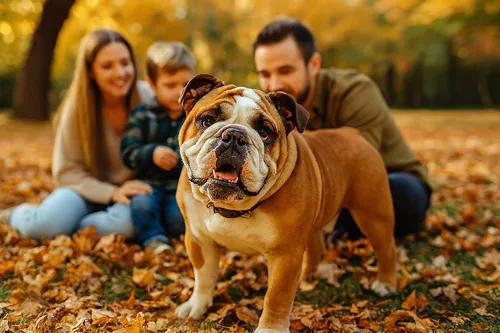
The Bulldog is one of the most recognisable dog breeds in the world, with its stocky build, wrinkled face and distinctive pushed-in nose.
Often known as the British Bulldog, it has become a national symbol, often associated with determination and resilience. Yet behind the iconic appearance lies a breed with a fascinating history, a gentle temperament and some specific care needs that every prospective owner should understand.
The Bulldog’s origins trace back to England in the thirteenth century, when it was bred for bull-baiting, a blood sport in which dogs were set upon bulls that were tied-up, and the breed’s name comes directly from this grim origin. Early Bulldogs were taller, more athletic and far more aggressive than the dogs we see today. Their role required courage, tenacity and a powerful jaw. When bull-baiting was outlawed in 1835, the Bulldog was in danger of vanishing almost overnight.
Rather than letting the breed disappear, enthusiasts began to reshape it. Through selective breeding, they reduced its aggression and created a calmer, more companionable dog. The modern Bulldog emerged in the late nineteenth century, shorter in stature, broader in build and with a much more placid nature. This transformation was so complete that the Bulldog went from a feared sporting dog to a beloved household pet in just a few generations.
Today’s Bulldog is a medium-sized dog, typically weighing between 18 and 25 kilograms, with males slightly heavier than females. They stand around 31 to 40 centimetres at the shoulder. Their body is muscular and low to the ground, with a wide chest and sturdy limbs. The head is large and square, with loose skin forming characteristic folds around the face and neck. The short muzzle and undershot jaw give the Bulldog its unmistakable expression.
One of the breed’s greatest strengths is its temperament. Bulldogs are known for being affectionate, dependable and good-natured. They form strong bonds with their families and are generally patient with children, making them a popular choice for households. They are not high-energy dogs, preferring short bursts of play followed by long periods of rest. This makes them well suited to both houses and flats, provided they get daily walks and interaction.
For families with children, the Bulldog’s calm and tolerant nature is a real asset. They are rarely snappy and tend to be steady even in busy environments. However, their solid build means supervision is still important with very young children, as they can accidentally knock them over. Bulldogs are also known to be sociable with other pets if introduced properly.
Bulldogs require medium maintenance. Their short coat is easy to groom, requiring only weekly brushing to remove loose hair, but their facial folds need regular cleaning to prevent moisture and bacteria build-up, which can lead to skin infections. They are also prone to drooling, so owners should be prepared for a bit of a mess. Exercise needs are modest, but it is important not to over-exert them, especially in hot weather, as their short muzzle makes them prone to overheating.
Health is an area where Bulldogs require careful attention. The breed is susceptible to a number of issues, many linked to its distinctive physical traits. Brachycephalic obstructive airway syndrome can cause breathing difficulties, particularly in warm or humid conditions. Hip dysplasia, skin fold dermatitis and cherry eye are also relatively common. Their short nose and compact build mean they are not natural swimmers and should be closely supervised around water. Responsible breeders work to reduce these risks by selecting for healthier traits, and prospective owners should always seek out breeders who follow health testing guidelines.
Despite these challenges, Bulldogs remain hugely popular. In the UK, they consistently rank within the top ten most registered breeds with The Kennel Club. In the United States, the American Kennel Club lists them in a similar position, often in the top five. Their appeal lies in their combination of distinctive looks, gentle personality and adaptability to different lifestyles.
The Bulldog’s popularity has also made it a cultural icon. It appears in sports team mascots, military insignia and advertising campaigns. In Britain, it is often used as a symbol of national spirit, particularly in reference to the Second World War. Yet for most owners, the Bulldog is simply a loyal companion who enjoys being part of the family.
Owning a Bulldog is a commitment to providing the right care and environment. They thrive in homes where they can be close to their people, with moderate exercise, regular grooming and attention to their health needs. In return, they offer affection, loyalty and a calm presence that fits well into many households.
The Bulldog’s journey from a fierce bull-baiting dog to a gentle family pet is one of the most remarkable transformations in canine history. It is a breed that has adapted to changing times while retaining its distinctive character. For those willing to meet its needs, the Bulldog can be a devoted and endearing companion for many years.
